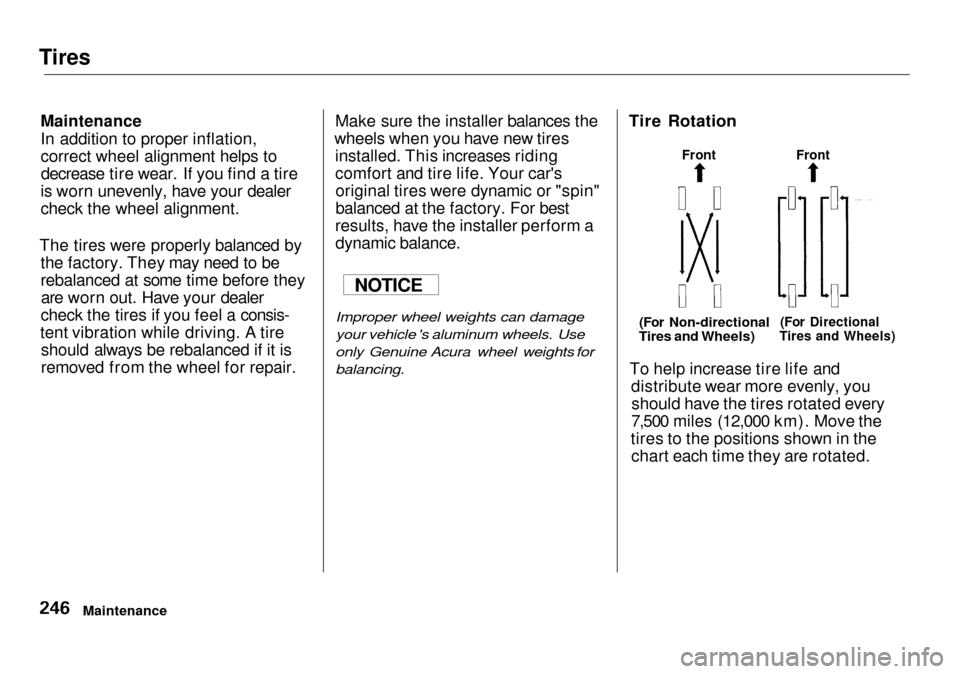Page 221 of 333
Engine Oil
The numbers on the container's label tell you the oil's viscosity or weight.Select the oil for your car according
to this chart.
An oil with a viscosity of 5W-30 is
preferred for optimum fuel economy
and year-round protection in your
Acura. You may use a 10W-30 oil if
the temperature in your area never
goes below 20°F(—7°C).
Synthetic Oil
You may use a synthetic motor oil if it meets the same requirements
given for conventional motor oil: it displays the API Certification Seal,
and it is the proper weight as shown
on the chart. When using synthetic
oil, you must follow the oil and filter
change intervals given in the
maintenance schedule. Additives
Your Acura does not need any oiladditives. Purchasing additives for
the engine or transmission will not increase your car's performance or
longevity. It only increases the cost of operating your car.
Maintenance
Ambient Temperature
Page 249 of 333

Tires
Maintenance
In addition to proper inflation,
correct wheel alignment helps todecrease tire wear. If you find a tire
is worn unevenly, have your dealer
check the wheel alignment.
The tires were properly balanced by the factory. They may need to be
rebalanced at some time before theyare worn out. Have your dealer
check the tires if you feel a consis-
tent vibration while driving. A tire should always be rebalanced if it is
removed from the wheel for repair. Make sure the installer balances the
wheels when you have new tires installed. This increases riding
comfort and tire life. Your car'soriginal tires were dynamic or "spin"
balanced at the factory. For best
results, have the installer perform a dynamic balance.
Improper wheel weights can damageyour vehicle 's aluminum wheels. Use
only Genuine Acura wheel weights for
balancing.
Tire Rotation
To help increase tire life and distribute wear more evenly, youshould have the tires rotated every
7,500 miles (12,000 km). Move the
tires to the positions shown in the chart each time they are rotated.
Maintenance
Front
NOTICE
(For Non-directional
Tires and Wheels)
(For Directional
Tires and Wheels)
Front
Page 300 of 333
Emergency Towing
If you decide to tow your car with all
four wheels on the ground, make sure you use a properly-designed and
attached tow bar. Prepare the car for
towing as described above, and leave
the ignition switch in Accessory (I) so the steering wheel does not lock.
Make sure the radio and any items
plugged into the accessory power socket are turned off so they do not
run down the battery.
The steering system can be damaged if
the steering wheel is locked. Leave the
ignition switch in Accessory (I), and
make sure the steering wheel turns
freely before you begin towing. Trying to lift or tow your car by the
bumpers will cause serious damage. The bumpers are not designed to
support the car's weight.
Taking Care of the Unexpected
NOTICE
NOTICE
Page 327 of 333

Index
Fan, Interior.......................... 126, 131
Features, Comfort and
Convenience............................... 121
Filling the Fuel Tank..................... 169
Filters
Air Cleaner................................. 231
Air Conditioning........................ 242
Oil................................................ 219
Flashers, Hazard Warning.............. 70
Flat Tire, Changing a.................... 273
Fluids Automatic Transmission........... 228
Brake........................................... 229
Differential................................. 229
Power Steering........................... 230
Windshield Washer................... 227
FM Stereo Radio
Reception........................... 137, 147
Fog Lights......................................... 67
Foreign Countries, Driving in...... 307
Four-way Flashers...........................
70
Front
Airbags.............................. 9,
43
Fuel..................................................
168
Fill Door and Cap....................... 169
Gauge............................................ 60
Octane Requirement................. 168
Oxygenated................................ 306
Reserve Indicator......................... 57
Tank, Filling the......................... 169
Fuel Mileage, Improving............... 173
Fuses, Checking the...................... 292
Gasohol........................................... 306
Gasoline.......................................... 168
Fuel Reserve Indicator................ 57
Gauge............................................ 60
Octane Requirement................. 168
Tank, Filling the......................... 169
Gas Station Procedures................. 169
Gauges.............................................. 58
Engine Coolant Temperature .... 60
Fuel................................................ 60
Speedometer................................ 58
Tachometer.................................. 58
GAWR (Gross Axle Weight
Rating)........................................ 197
Gearshift Lever Positions............. 182
Glass Cleaning............................... 268
Glove Box......................................... 88
GVWR (Gross Vehicle Weight
Rating)........................................ 197
Halogen Headlight Bulbs.............. 252
Hazard Warning Flashers............... 70
Headlights Automatic Lighting..................... 64
Daytime Running Lights............. 65
High Beam Indicator................... 57Lights On Indicator..................... 55
Reminder Chime.......................... 63
Replacing Halogen Bulbs......... 252
Turning on.................................... 63
Head Restraints............................... 96
Heating and Cooling...................... 122
High Altitude, Starting at.............. 181
High-Low Beam Switch .................. 63
High-mount Brake Light............... 257
HomeLink Universal
Transmitter.................................. 89
Hood Latch..................................... 231
Hood, Opening the........................ 170
Horn................................................... 62
Hydroplaning.................................. 195
Page:
< prev 1-8 9-16 17-24